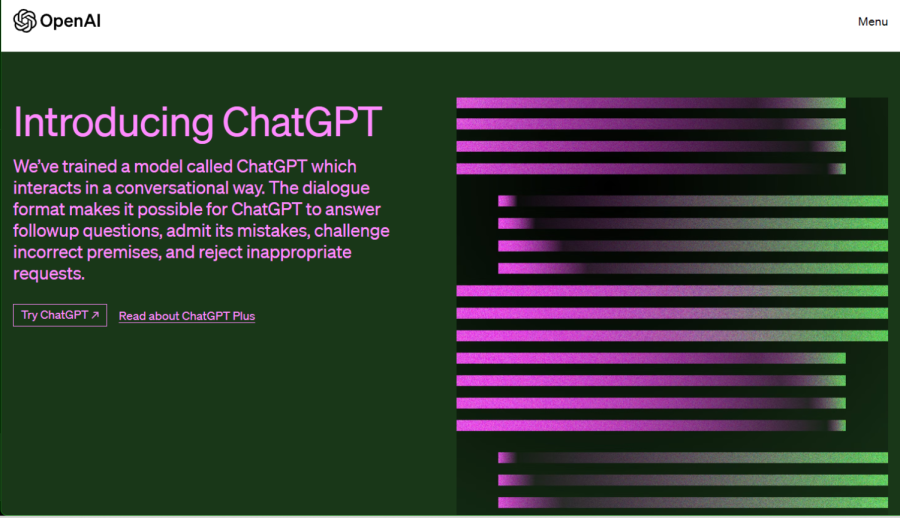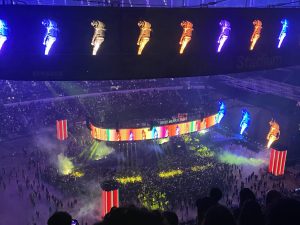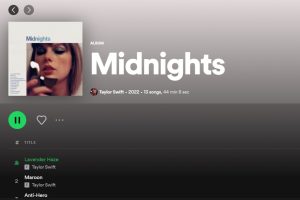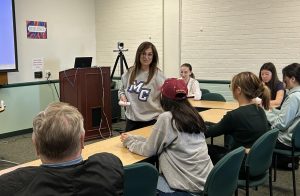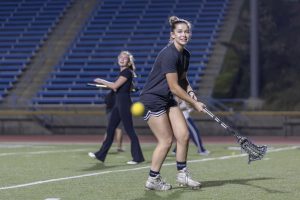ChatGPT ushers in a new era of uncertainty and controversy
April 27, 2023
ChatGPT is a conversational Artificial Intelligence software that is designed to mirror and communicate with humans.
It was released in 2022 by the tech company Open AI, which went viral earlier that year with their AI art generator DALL-E.
ChatGPT is well-versed in a large range of topics. It can write about virtually anything and even has the ability to generate computer code. The technology can also read text and explain to the user what is being read.
Not only does ChatGPT understand the various writing formats that high school and college students are expected to know (MLA, AP, Chicago etc.), it also knows how to adjust its writing to different skill levels. When the software is asked to write a paper at a high school level, that paper will look different than what it would look life if ChatGPT was asked to write it at a college level.
It is important to note that ChatGPT is completely open to the public, allowing anyone to test out the chatbot.
Open AI released a statement urging users to provide feedback on the chatbox’s abilities.
“Users are encouraged to provide feedback on problematic model outputs through the UI, as well as on false positives/negatives from the external content filter which is also part of the interface,” Open AI stated.
ChatGPT isn’t out of its beta stage yet, which means that Open AI is still working to fix errors in the software, including algorithm bias and inappropriate responses. The company approaches these issues by administrating the chatbot’s conversations and preventing the software from further discussing any conversations deemed inappropriate.
“We are particularly interested in feedback regarding harmful outputs that could occur in real-world, non-adversarial conditions, as well as feedback that helps us uncover and understand novel risks and possible mitigations,” Open AI stated.
In addition to being a new kind of software, ChatGPT is also a new concept, overall. Prior to its release, a mass publicized chatbot with such highly-advanced features had never been introduced before.
Trudi Radtke, the instructional technologist and designer at Moorpark College, gave their input on ChatGPT and its possible societal impacts.
Radtke explained that 22% of the data that was used to develop and train ChatGPT came from threads on Reddit with more than three upvotes.
This raises some concerns over the fairness and reliability of the chatbot’s responses. There is a growing worry over the chatbot giving out biased responses to users’ questions. This bias is common in machine learning and has always been an difficult hurdle for AI researchers to overcome.
Radtke explained that the first step in the adaptation of ChatGPT must be to understand how the software actually works.
“I’m really more interested in having conversations that have to do with how AI actually works. You know, what is algorithm bias? If we depend on a chatbot to answer our questions, do we understand how the chatbot got to that question, do we understand the data that it was trained on?” Radtke asked.
60% of the datasets used to develop Chat GPT were pulled from Common Crawl, an organization that searches the internet for non-copyrighted material. Another 15% came from datasets of books that were free to use and a final 3% came from Wikipedia.
Radtke was able to learn these details from Cornell University’s thesis publication website. Detailed information on how the software works isn’t easy to find since Open AI is using their right of proprietary discretion, which allows companies to keep work for upcoming products private information for the company.
“It makes sense, it’s not a bad thing to have, but the problem is that it allows AI companies like Open AI to kind of gatekeep how their algorithm was trained, so that type of information is not easy to find,” Radtke said. “You have to know where to look, you have to be a researcher, and I have a sneaking suspicion that this type of information is going to get more difficult to find as AI progresses.”
Chat GPT is also limited by an information cutoff, which means that it’s database contains only information available prior to September of 2021. This can lead to some inaccuracies in the responses that the chatbot gives, depending on if it’s answers are up-to-date or not.
With Microsoft partnering with Open AI and investing 10 billion dollars into the company, other technology companies will likely begin competing for the chatbot market. Radtke believes that companies will continue to make it difficult to find out their training practices for AI because of the potential market that will open up as AI becomes more regularly used.
Open AI recently announced its new software called GPT-4, which they claim is the ChatGPT upgrade. This next-level software passed several forms of standardized testing including AP exams and the SAT. Additionally, the software performed in the 90th percentile for the BAR exam and has the advanced ability to undertsand and interpret images.
Open AI put out a disclaimer stating that this new model is also not yet perfect. GPT-4 has an information cutoff as well, can make simple reasoning errors, be confidently wrong in it’s answers and overly gullible to users’ assertions. This upgraded software also struggles with biases in its outputs.
“We have made progress on these but there’s still more to do. Per our recent blog post, we aim to make AI systems we build have reasonable default behaviors that reflect a wide swathe of users’ values,” Open AI stated.
ChatGPT has exploded in popularity as of recently. Social media platforms like TikTok have helped grow the software’s userbase. As a result, the virality of ChatGPT has given way for some people to abuse the technology. For example, online users have uploaded tutorials on how to make the AI summarize homework reading, compose essays and write computer code.
This new trend of using ChatGPT to ace schoolwork has stirred controversy within the education community. School administrators, including leadership at Moorpark College, have begun to discuss how to handle this new technology. With how quickly it’s advancing, some school officials are thinking of ways to integrate the technology into education rather than banning it altogether.
Sergio Mendieta, Associated Students of Moorpark College’s director of student organizations, gave his thoughts on how ChatGPT should be handled by school administrators.
“There are ways to catch and stop students from using it [ChatGPT] in the form of ChatGPT Zero, a software that can detect the outputs and wording of ChatGPT, and this is probably the approach schools will take initially. However, I don’t think being restrictive is the way to go with this new technology,” Mendieta said.
Mendieta drew a comparison to the use of calculators in math classrooms, which have allowed students to focus on higher-level problem-solving rather as opposed to repetitive calculations.
Mendieta suggests that ChatGPT could be used to generate practice problems, summaries, analyses of texts, improve vocabulary and assist in grading certain assignments. He further argues that the platform could also serve as a valuable resource for educators by generating grading rubrics and email templates.
While harping on the possible benefits of the ChatGPT, Mendieta agreed that concerns over increased occurrences of cheating and plagiarism as a result of the AI software are valid.
“Though cheating is a concern, students only serve to hurt themselves by using it if they use it too often,” Mendieta said. “Chat GPT will cause students to fail tests and such if relied on too heavily.”
With the AI technology industry rapidly expanding, schools will likely learn how to integrate ChatGPT into their education system and instruct students to work with the AI rather than to cheat with the AI. Regardless of which direction this technology heads toward, many would agree that the chatbot’s seemingly endless possibility of uses will continue to be taken advantage of in the near future.



